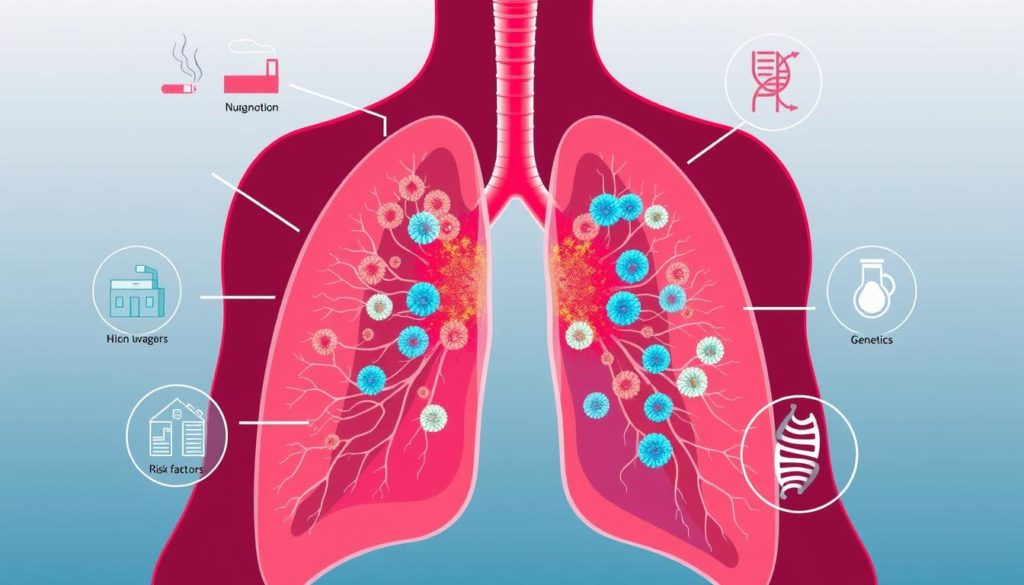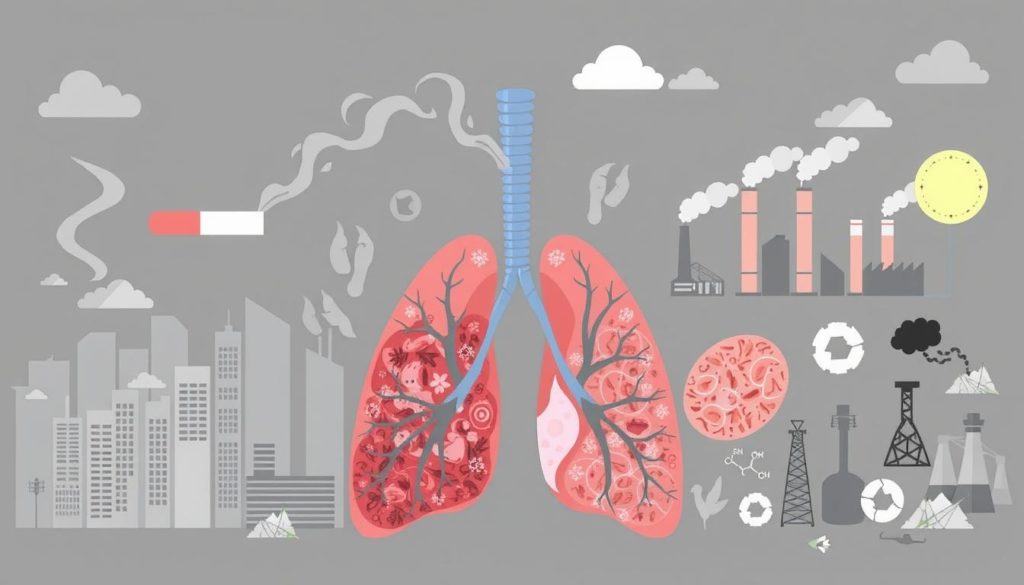Did you know about 85% of lung cancer falls under non-small-cell lung cancer (NSCLC)? It’s vital to know NSCLC risk factors. This knowledge can help in prevention and early detection, saving many lives.
Understanding Non-Small-Cell Lung Cancer Risk Factors is key to prevention. This article will inform you about NSCLC risk factors. You’ll learn about causes like smoking, genetic factors, and lifestyle. With this info, you can take steps to reduce your risk and help others too.
Join us as we dive into how to safeguard yourself and others from lung cancer.
Understanding Non-Small-Cell Lung Cancer (NSCLC)
Non-Small-Cell Lung Cancer (NSCLC) covers about 85% of lung cancer cases. Unlike small-cell lung cancer, NSCLC has bigger cells with different traits. Knowing about NSCLC is key for proper diagnosis and choosing the best treatment.

What is NSCLC?
NSCLC groups lung cancers with similar behavior, like squamous cell carcinoma, adenocarcinoma, and large cell carcinoma. NSCLC often grows and spreads slower than small-cell types. This slower growth affects treatment choices and patient outlooks.
Types of NSCLC
NSCLC comes in three main types:
- Adenocarcinoma: This is the most usual type, forming around 40% of lung cancers. It starts in the lung’s mucus-making cells.
- Squamous Cell Carcinoma: Making up 25-30% of lung cancers, it begins in the cells that line the airways.
- Large Cell Carcinoma: With 10-15% of lung cancers, this kind can grow in any lung area. It often grows and spreads faster than other NSCLC types.
| Subtype | Prevalence | Characteristics |
|---|---|---|
| Adenocarcinoma | 40% | Begins in mucus-producing glandular cells |
| Squamous Cell Carcinoma | 25-30% | Starts in the squamous cells lining the airways |
| Large Cell Carcinoma | 10-15% | Can appear in any part of the lung; tends to grow aggressively |
Primary Causes of Lung Cancer
Lung cancer’s main causes are critical to understand for prevention and early detection. This knowledge is key because lung cancer is very serious. Research and health actions focus a lot on this.

The Role of Smoking in Lung Cancer
Smoking greatly increases lung cancer risk, accounting for about 85% of cases. Tobacco smoke has nicotine, tar, and over 70 known cancer-causing substances. These chemicals harm lung cells.
Eventually, this harm can change the DNA in these cells. This makes them grow out of control and form tumors. The more you smoke, the higher your risk of lung cancer.
Exposure to Secondhand Smoke
Being around secondhand smoke also raises lung cancer risk. If you don’t smoke but breathe in secondhand smoke, you have a 20-30% higher chance of getting lung cancer. Secondhand smoke has many harmful chemicals, just like directly inhaled smoke. It’s important to avoid secondhand smoke at home, work, or when out and about.
| Cause | Impact on Lung Cancer Risk |
|---|---|
| Smoking | 85% of lung cancer cases |
| Secondhand Smoke | 20-30% higher risk for non-smokers |
Environmental Risk Factors for NSCLC
Non-Small-Cell Lung Cancer (NSCLC) comes from many environmental sources. Knowing these factors helps create better prevention plans.
Air Pollution and Lung Cancer
Air quality affects lung health. Long time in polluted air, especially in cities, boosts lung cancer risks. Things like factory smoke, car fumes, and home pollutants make air worse, raising NSCLC cases.
Occupational Hazards
Keeping workplaces safe helps prevent lung cancer. Some jobs expose people to bad stuff like asbestos, silica, and diesel smoke. These can cause cancer. Making sure industries follow safety rules can lower lung disease risks.
Radon Exposure
Radon is a natural gas that can cause cancer. It comes from the ground and can get into houses. It’s the second biggest cause of lung cancer after smoking. Testing and fixing radon problems can make homes safer.
Genetic Factors in Lung Cancer
Genetic factors play a big role in lung cancer. If lung cancer runs in your family, your own risk may be higher. This shows how genetics help us understand personal risks.
Family History and Genetic Predisposition
Family history is key in looking at lung cancer. Having a close relative with lung cancer raises your own risk. Knowing your family’s health history helps find if you’re at higher risk.
Gene Mutations Associated with NSCLC
Certain gene mutations increase the risk of Non-Small-Cell Lung Cancer (NSCLC). Changes in EGFR, KRAS, and ALK genes are important examples. These mutations can affect treatment success and the disease outcome.
| Gene | Mutation Effect | Associated Risk |
|---|---|---|
| EGFR | Enhanced tumor growth | High |
| KRAS | Increased cell proliferation | Moderate |
| ALK | Altered cell signaling | Moderate |
It’s vital to keep researching genetic factors and family history in lung cancer. This knowledge helps us create better screening processes. With it, we can tailor treatments to each patient, improving their chances.
The Impact of Lifestyle Choices
It is key to understand how lifestyle choices affect the risk of lung cancer, specifically non-small-cell lung cancer (NSCLC). Many studies have shown that making healthy changes can significantly lower the risk of NSCLC. We will explore how diet, nutrition, and staying active can help prevent lung cancer.
Diet and Nutrition
Eating well is vital for cancer prevention through diet. Adding lots of fruits, vegetables, and whole grains to your diet strengthens the body’s defense against cancer. Diets rich in antioxidants and phytochemicals, found in things like leafy greens and berries, can lower the risk of NSCLC. Also, eating less red and processed meats and cutting down on sugar is good for lung health.
Physical Activity
Being active is great for exercise and lung health. Staying active improves lung function and reduces the chance of getting NSCLC. Exercise helps keep a healthy weight and strengthens the immune system, helping to prevent cancer. Simple activities like walking, biking, or swimming every day can greatly reduce the risk of NSCLC.
Looking at the benefits of these lifestyle changes, we see the following:
| Factor | Benefits |
|---|---|
| Healthy Diet | Reduces risk of NSCLC, improves immune function |
| Regular Exercise | Enhances lung health, aids in cancer prevention |
| Weight Management | Lowers cancer risk, promotes overall well-being |
Adding these lifestyle habits to NSCLC prevention strategies leads to healthier living and lowers cancer risks. Focusing on preventing cancer through diet and staying active is a key way to better lung health.
Non-Small-Cell Lung Cancer Risk Factors
Knowing about NSCLC risk factors is key for assessing lung cancer risk thoroughly. Many things can lead to non-small-cell lung cancer. These include lifestyle choices, places we live, and our family’s health history.
Learning about these factors helps people figure out their risk and act to prevent cancer. Here’s a look at the main risks for NSCLC:
| Risk Factor | Description |
|---|---|
| Smoking | Primary cause of lung cancer; includes both active and passive smoking. |
| Air Pollution | Environmental element linked to increased cancer risk, especially in urban areas. |
| Occupational Hazards | Exposure to carcinogens at work such as asbestos, which heightens NSCLC risk. |
| Radon Exposure | Radioactive gas found in homes that can lead to increased lung cancer risk. |
| Family History | Genetic predisposition to lung cancer indicated by family medical history. |
| Gene Mutations | Specific genetic changes that contribute to the occurrence of NSCLC. |
| Diet and Nutrition | Poor dietary habits can influence lung cancer risk. |
| Physical Activity | Lack of exercise is another aspect impacting the likelihood of developing lung cancer. |
Putting NSCLC risk factors into lung cancer checks helps people manage their health better. This way, they can take steps to stay as healthy as possible.
Prevalence of NSCLC in the United States
Learning about lung cancer’s impact in the USA shows us how big this health challenge is. NSCLC statistics tell us it’s a leading cancer type in the nation, according to healthcare reports.
Every year, thousands are diagnosed, with NSCLC making up 80-85% of these cases. The Centers for Disease Control and Prevention (CDC) shows many are affected. This tells us we need better prevention and treatments.
Lung cancer affects both men and women, with some differences among groups. Here’s a look at the latest numbers:
| Year | Total Diagnosed Cases | Percentage of NSCLC Cases |
|---|---|---|
| 2020 | 228,820 | 84% |
| 2021 | 235,760 | 83.5% |
The growing lung cancer prevalence in the USA shows the need for more research and health efforts. These numbers highlight the fight against lung cancer must continue to save lives.
How to Minimize Your Risk of Lung Cancer
To lower your lung cancer risk, take several steps focusing on lifestyle and environment. Follow the advice given to reduce your chance of getting Non-Small-Cell Lung Cancer (NSCLC). We start by stressing the need to stop smoking.
Quitting Smoking
Stopping smoking is key to cutting your lung cancer risk. Use aids like nicotine replacements, counseling, and meds. The American Lung Association says using more than one method helps a lot. Getting help from quit programs offers extra support too.
Reducing Exposure to Carcinogens
Avoid environmental and workplace carcinogens to fight lung cancer. Stay away from secondhand smoke and radon. Use air purifiers, as the Environmental Protection Agency (EPA) advises. Follow work safety rules to protect yourself from dangerous chemicals.
Healthy Living Tips
Healthy living is crucial in preventing lung cancer. Eating lots of fruits and veggies, staying active, and keeping a healthy weight are key. The Centers for Disease Control and Prevention (CDC) backs these habits. They improve your overall health and cancer defense.
By following these measures, you greatly reduce your lung cancer risk. It’s beneficial for both your physical and environmental well-being. It’s never too late to start making healthier choices, no matter your past habits.
FAQ
What are the primary risk factors for Non-Small-Cell Lung Cancer (NSCLC)?
Key risk factors for NSCLC include smoking and secondhand smoke. Air pollution and occupational hazards like asbestos also play a role. Additionally, radon exposure and genetic factors, such as family history and certain gene mutations, are important.
How does smoking increase the risk of lung cancer?
Smoking fills the lungs with harmful chemicals, leading to mutations. These mutations can cause lung cancer. Smoking is the top cause of lung cancer, being responsible for about 85% of cases.
Can secondhand smoke affect my lung cancer risk?
Absolutely. Secondhand smoke has the same harmful chemicals as direct smoking. Being around it often can raise your chances of getting NSCLC.
How does air pollution contribute to lung cancer?
Air pollution has tiny harmful particles. It also contains toxic chemicals. Long exposure to polluted air can damage lungs and increase cancer risk.
What are some occupational hazards that can lead to NSCLC?
Jobs that expose you to asbestos, silica dust, and diesel exhaust can be dangerous. These substances can harm your lungs and may cause cancer.
How does radon exposure impact lung cancer risk?
Radon is a radioactive gas found in homes and buildings. Being around high levels of radon for a long time can harm lung cells and boost cancer risk.
What genetic factors are associated with lung cancer?
If lung cancer runs in your family, your risk goes up. Certain genes like EGFR, KRAS, and ALK have also been linked to NSCLC.
Can lifestyle choices like diet and physical activity affect lung cancer risk?
Definitely. Eating lots of fruits and vegetables and staying active are good for your lungs. These habits could help lower your lung cancer risk.
What are some effective strategies to minimize my risk of developing NSCLC?
To lower your risk, quit smoking and stay away from secondhand smoke. Test your home for radon and fix any problems. Use protective equipment in risky jobs. Also, eat healthy and exercise regularly.


